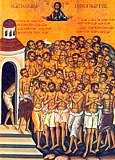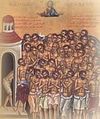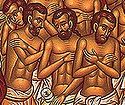

| Previous day | Next day |
| Old Style
March 9
|
Tuesday |
New Style
March 22
|
|
3rd Week of Great Lent.
Tone 6.
Great Lent. |
Wine and oil allowed.
|
![]() The Holy Forty Martyrs of Sebaste: Cyrion (or Quirio), Candidus, Domnus, Hesychius, Heraclius, Smaragdus, Eunoicus, Valens, Vivianus, Claudius, Priscus, Theodulus, Eutychius, John, Xanthias, Helianus, Sisinius, Angus, Aetius, Flavius, Acacius, Ecdicius, Lysimachus, Alexander, Elias, Gorgonius, Theophilus, Dometian, Gaius, Leontius, Athanasius, Cyril, Sacerdon, Nicholas, Valerius, Philoctimon, Severian, Chudion, Aglaius, and Meliton (ca. 320).
The Holy Forty Martyrs of Sebaste: Cyrion (or Quirio), Candidus, Domnus, Hesychius, Heraclius, Smaragdus, Eunoicus, Valens, Vivianus, Claudius, Priscus, Theodulus, Eutychius, John, Xanthias, Helianus, Sisinius, Angus, Aetius, Flavius, Acacius, Ecdicius, Lysimachus, Alexander, Elias, Gorgonius, Theophilus, Dometian, Gaius, Leontius, Athanasius, Cyril, Sacerdon, Nicholas, Valerius, Philoctimon, Severian, Chudion, Aglaius, and Meliton (ca. 320).
Martyr Urpasianus of Nicomedia (ca. 295). St. Caesarius, brother of St. Gregory the Theologian (ca. 369). St. Tarasius the Wonderworker, of Lycaonia. Translation to Vladimir of the relics of Martyr Abraham of the Bulgars on the Volga (1230). St. Jonah, archbishop of Novgorod (1470). St. Theodosius Levitsky, priest, of Balta (Odessa) (1845). St. Dimitra, nun and foundress of the Vvedensk Convent in Kiev (1878).
New Hieromartyrs Mitrophan Buchnoff, archpriest, of Voronezh (1931), and Ioasaph (Shakhov), abbot, of Popovka (Moscow) (1938). New Hieromartyrs Sergius Lebedev, Sergius Tsvetkov, and Alexis Smirnov, archpriests, and Dimitry Glivenko, priest, all of the Moscow region (1938).
“Albazin” Icon of the Most Holy Theotokos (“The Word Was Made Flesh”) (1666).
St. Philoromus the Confessor, of Galatia (4th c.). St. Pacianus, bishop of Barcelona (390). St. Bosa, bishop of York (705). St. Vitalis of Castronovo (994). New Martyrs (two priests and forty students) of Momisici (Montenegro) (1688).
Repose of Elder Cleopas of Ostrov-Vvedensk Monastery (1778), Schema-abbot Theodosius (Pomortsev) of Optina Monastery (1920), and Schema-archimandrite Theophilus of Kiev (1996).
Thoughts for Each Day of the Year
According to the Daily Church Readings from the Word of God
By St. Theophan the Recluse

Wednesday.
It is remarkable that Wisdom calls the foolish to herself: Whoso is simple, let him turn in hither (Prov. 9:4).[1] Thus, the clever cannot enter into the house of Wisdom, or the holy Church. Any cleverness must be laid aside at the very entrance to this house. On the other hand, if all wisdom and knowledge are only located inside the house of Wisdom, then outside of this house, outside of the holy Church there is only foolishness, ignorance and blindness. How marvellous is God’s institution! Leave your intellect behind upon entering the Church, and you will become truly intelligent; leave your independent activity and you will become truly active; deny all of yourself and you will become a true ruler over yourself. Oh, when will the world comprehend this wisdom! But this wisdom is hidden from the world. The world rebels against the wisdom of God because it does not understand that it, and keeps those foolish “clever ones” in its blindness
[1]The Slavonic for Prov. 9:4 reads Whoso is foolish, let him turn in hither.
Tuesday.
Wisdom—God the Word—hath builded her house—the holy Church—and in it she hath furnished her table, the word of God and the holy Mysteries, especially the Mystery of the Body and Blood. And she hath sent forth her maidens, the holy apostles and their successors, to call everyone to herself for the supper (Prov. 9:1–8). Many have already been called, but the calling still continues. So let the whole house be filled. The feast continues unceasingly. Glory be to God, Who is so merciful toward us. Let us all go! Let us enter in, let nobody remain outside the door. During these days of Lent the calling is particularly intensified, and the feast is particularly abundant. This makes it all the more inexcusable to be deprived of this supper. Let all carve in their memory the following words of Wisdom: he that sinneth against me wrongeth his own soul (Prov. 8:36); and so pity yourself.
Articles
 Martyr Urpasianus of NicomediaThe Holy Martyr Urpasianus suffered in the city of Nicomedia. |
 St. Caesarius, brother of St. Gregory the TheologianSaint Caesarius lived for a long time at the court of the emperor Constantius (337-361), and was his friend and chief court physician. |
 Icon of the Mother of God “The Word was made Flesh”The Albazin Icon of the Mother of God “the Word made Flesh” is of great religious significance in the Amur River region. |






